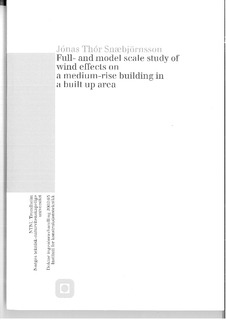| dc.contributor.author | Snæbjörnsson, Jónas Thór | nb_NO |
| dc.date.accessioned | 2014-12-19T11:57:57Z | |
| dc.date.available | 2014-12-19T11:57:57Z | |
| dc.date.created | 2002-10-07 | nb_NO |
| dc.date.issued | 2002 | nb_NO |
| dc.identifier | 122919 | nb_NO |
| dc.identifier.isbn | 82-471-5495-1 | nb_NO |
| dc.identifier.uri | http://hdl.handle.net/11250/236382 | |
| dc.description.abstract | The present study deals with full- and model scale study of wind effects on a medium-rise building in a built up area.
Most low-rise building experiments have been based on an isolated building placed in a relatively uniform terrain. Similarly, the very tall buildings often extend out from their environment in a similar fashion. However, buildings are constructed in various shapes and placed in different types of terrain and topography. Therefore, despite a number of studies made in the past, there are still problems that remain unsolved.
As the majority of office- and residential buildings in populated areas fall in the intermediate height category, it should be of interest to examine the wind effects acting upon such a building, as well as its dynamic response. For this purpose, an experimental program was initiated utilising a combination of full-scale measurements and wind tunnel studies, where the fluctuating wind actions are evaluated from recorded simultaneous point pressure fluctuations. Recent improvements in experimental techniques and data handling enable a more detailed information gathering that should eventually lead to an improved understanding of the pressure field around buildings.
The investigation studies, experimentally, the wind induced dynamic loading and response of a multi-story building of intermediate height. The presented work evolves on one hand around experimental data acquisition in both full- and model scale, whereas on the other it evolves around basic data reduction, understanding and interpretation of the acquired data.
The objective of the study is, in a way, to attempt to provide a sound wind loading chain a la Davenport [29], in the form of data that would facilitate the study of the links connecting the main parameters i.e. Wind – Load – Response. This entails the definition of the relevant wind parameters, the description of the aerodynamic loading process, such as the time-dependent variations of pressure fluctuations on the building surface, and an investigation of the wind induced response of a medium-rise building.
Information on the study-building and the experimental setup and procedures is given, for both full-scale and model scale. The full-scale and model scale data are systematically compared through the evaluation of descriptive parameters of both wind turbulence and surface pressures. In general, the evaluated full-scale parameters are found to be in qualitatively good agreement with the model scale parameters. However, the investigation revealed some characteristic differences between full-scale and model scale behaviour. These differences are largely related to the fact that significant variability is found to be inherent in the fullscale data, whereas considerably less variability seems to be associated with the wind tunnel data. | nb_NO |
| dc.language | eng | nb_NO |
| dc.publisher | Fakultet for ingeniørvitenskap og teknologi | nb_NO |
| dc.relation.ispartofseries | Dr. ingeniøravhandling, 0809-103X; 2002:95 | nb_NO |
| dc.subject | Engineering design | en_GB |
| dc.subject | TECHNOLOGY: Engineering mechanics: Construction engineering | en_GB |
| dc.title | Full- and Model Scale Study of Wind Effects on a medium-rise Building in a built up Area | nb_NO |
| dc.type | Doctoral thesis | nb_NO |
| dc.source.pagenumber | 200 | nb_NO |
| dc.contributor.department | Norges teknisk-naturvitenskapelige universitet, Fakultet for ingeniørvitenskap og teknologi | nb_NO |
| dc.contributor.department | Norges teknisk-naturvitenskapelige universitet, Fakultet for ingeniørvitenskap og teknologi, Institutt for konstruksjonsteknikk | nb_NO |
| dc.description.degree | dr.ing. | nb_NO |
| dc.description.degree | dr.ing. | en_GB |

